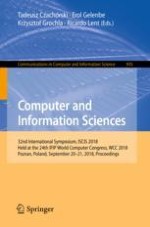2018 | Buch
Computer and Information Sciences
32nd International Symposium, ISCIS 2018, Held at the 24th IFIP World Computer Congress, WCC 2018, Poznan, Poland, September 20-21, 2018, Proceedings
herausgegeben von: Prof. Tadeusz Czachórski, Prof. Dr. Erol Gelenbe, Krzysztof Grochla, Ricardo Lent
Verlag: Springer International Publishing
Buchreihe : Communications in Computer and Information Science
